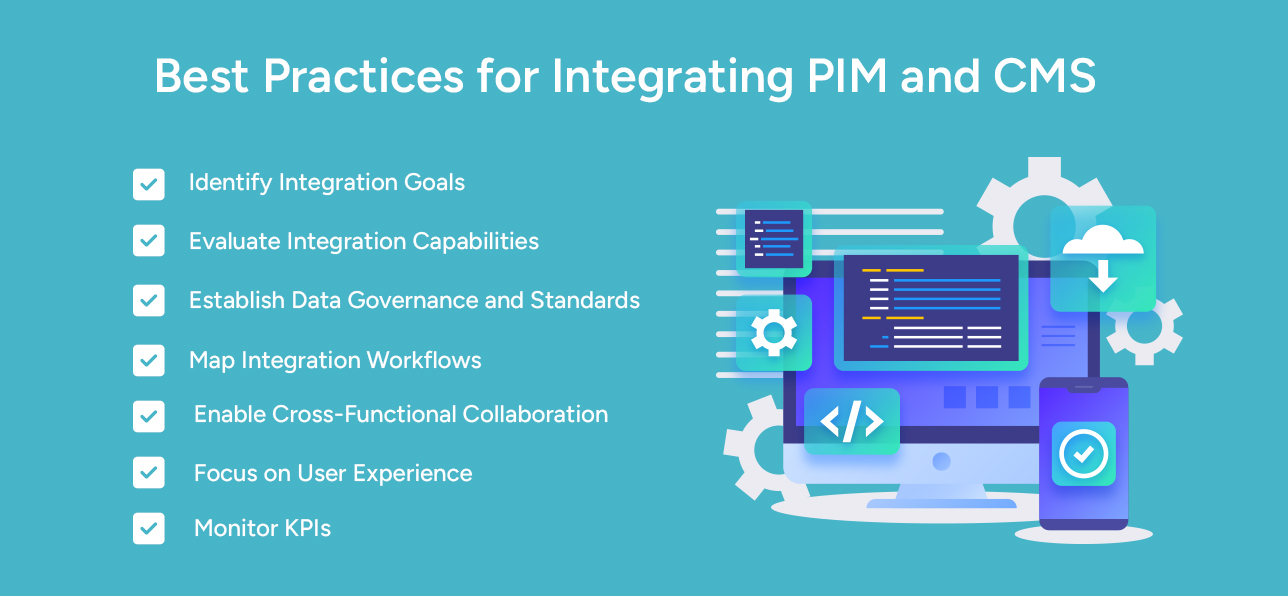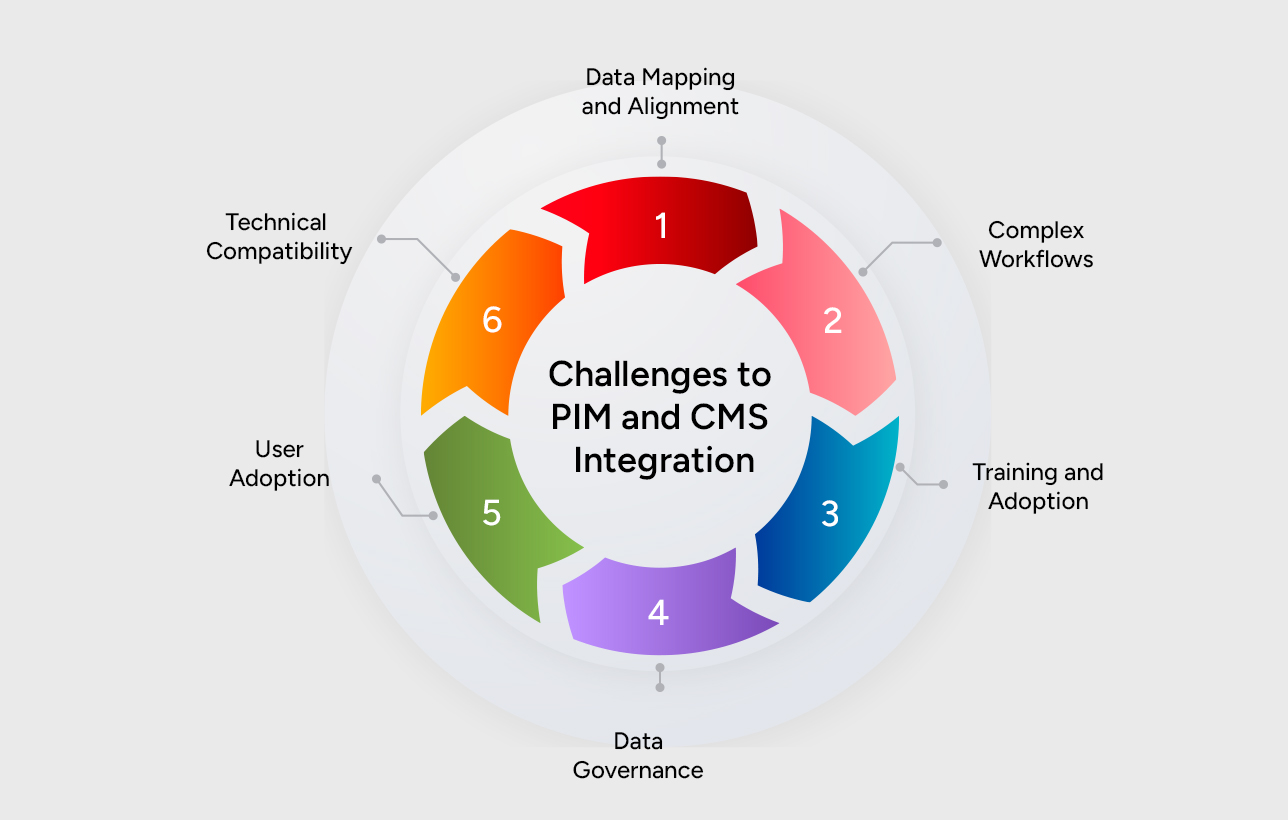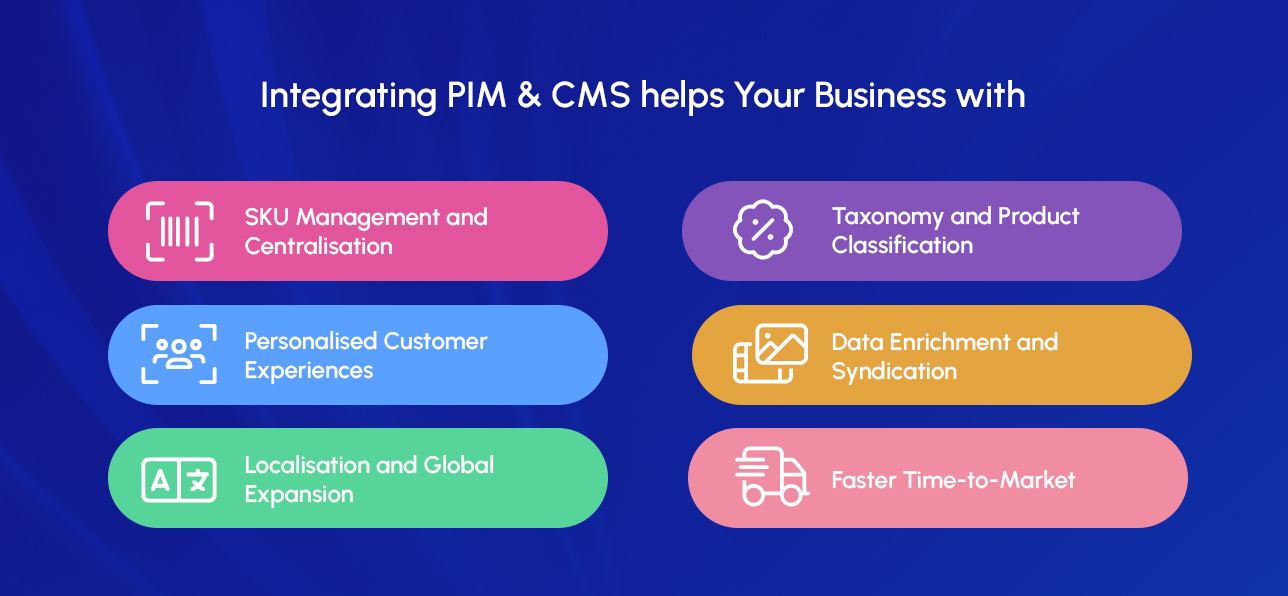Did you know, brands start losing 15-25% of their revenue due to inaccurate data? Who is to blame? Inaccurate data and inconsistency in the content distribution. Like most problems, we tend to ignore them until they become glaringly obvious. However, if you value the money you’ve invested in your business and want to tackle this issue, you need solutions that can effectively manage and present your product information and content.
Two powerful tools to consider are Product Information Management (PIM) and Content Management Systems (CMS). You can integrate these two to create a unified, robust strategy on behalf of your business. In fact, by 2025, 50% of organisations are expected to have invested in a PIM system, up from 20% in 2020. Additionally, 67% of companies utilise at least one CMS to enhance their omnichannel capabilities.
But before you hop on and integrate PIM with CMS, you need some key information to make an informed decision:
- What is PIM?
- What is CMS?
- Why PIM CMS integration is important?
- What are the best practices for integrating PIM and CMS?
- What are the challenges of integrating PIM and CMS?
- How can you ensure a smooth PIM and CMS integration?
Don’t worry, we have covered all these questions and so many in our upcoming sections. Have a happy read!
What is PIM?
Product Information Management (PIM) systems play a crucial role for retailers dealing with extensive product inventories. These systems centralise all product data, making it easier to manage and distribute information across various channels. This ensures that product details are always accurate, consistent, and current.
By centralising product data, the PIM solution simplifies the process of updating information across eCommerce sites, print and digital catalogues, and internal databases. This means that any change made in the PIM system is automatically reflected across all sales and marketing channels, reducing the risk of errors and inconsistencies.
What is CMS?
A Content Management System (CMS) is a software tool that empowers businesses to create, manage, and publish digital content easily. It's the backbone of a company's online presence, used for organising everything from website content to blogs, landing pages, and other digital assets.
And why shouldn’t that be the case? With a CMS designed for B2B, businesses can ensure their audience always sees engaging and relevant content, no matter where they encounter it. This is vital for maintaining a consistent brand message across all digital platforms, from websites to social media.
The intuitive interface of most CMS platforms makes it accessible for users of all skill levels to update content, add new pages, or tweak designs without needing advanced technical knowledge.
Why Integrate PIM and CMS in your B2B Business?
Integrating PIM and CMS brings several strategic advantages to B2B retailers that go beyond operational efficiency.
- Streamlined SKU Management and Centralisation
How? By integrating PIM and CMS, product data is managed through a single, centralised system. This centralisation ensures that product information is consistent and up-to-date across all digital platforms, such as websites, mobile apps, and marketplaces. The PIM system automates data updates, reducing manual entry errors and ensuring data accuracy, which builds customer trust and satisfaction.
- Enhanced Taxonomy and Product Classification
How? The integration aligns product data with content management strategies, enabling businesses to create intuitive navigation and search functionalities on their websites. The PIM system structures product data efficiently, while the CMS uses this structured data to enhance the site’s taxonomy, simplifying the customer journey and improving user experience. This leads to higher engagement and conversions.
- Personalised Customer Experiences
How? By combining detailed product information from the PIM with customer insights and preferences managed through the CMS, businesses can deliver targeted content and recommendations. The PIM provides enriched product data, while the CMS uses this data along with customer profiles to personalise interactions. This customisation enhances customer satisfaction, boosts retention, and fosters loyalty.
- Data Enrichment & Syndication Across Multiple Channels
How? Integration ensures product information is optimised for various platforms and marketplaces. The PIM system handles data enrichment, ensuring product details are complete and accurate, while the CMS syndicates this information across different channels. This enhances visibility and reach, supports localised content management, and aids in global expansion by tailoring offerings to diverse markets while maintaining consistent brand messaging.
- Reduced Time-to-Market for New Products and Updates
How? By automating data workflows and content publishing processes, the integrated PIM and CMS system speeds up the launch of new products and updates. The PIM system efficiently manages product data, and the CMS automates content updates and publishing, enabling businesses to quickly roll out campaigns and promotions. This agility helps seize market opportunities and stay ahead of competitors.
All in all, PIM CMS integration is not just about operational efficiency but also about enhancing customer experiences, optimising marketing efforts, and supporting business growth in a dynamic digital landscape. It empowers businesses to deliver compelling content and personalised interactions that resonate with their audience, driving both short-term sales and long-term brand loyalty.
Best Practices for Integrating PIM and CMS

Integrating Product Information Management (PIM) and Content Management System (CMS) involves several key best practices to ensure seamless operation and maximise benefits:
- Identify Integration Goals: Clearly define what you aim to achieve through integration, such as improved data consistency, enhanced customer experience, or faster time-to-market.
- Evaluate Integration Capabilities: Assess the technical capabilities of your PIM and CMS platforms to determine compatibility and identify any necessary customisations or integrations.
Related Read: The Ultimate Guide to Product Information Management (PIM)
3. Establish Data Governance and Standards: Set clear guidelines for data quality, consistency, and security to maintain accuracy across all channels.
4. Map Integration Workflows: Map out how product data will flow between PIM and CMS, ensuring efficient processes for updating, publishing, and retiring content.
5. Enable Cross-Functional Collaboration: Foster collaboration between teams responsible for product management, marketing, IT, and customer support to ensure alignment and smooth execution.
Related Read: Headless vs. Traditional CMS - Understanding the Divide
6. Focus on User Experience: Design interfaces and workflows that prioritise usability and intuitive navigation for both content managers and end-users.
7. Monitor KPIs: Define key performance indicators (KPIs) related to data accuracy, content engagement, and operational efficiency to measure the success of integration efforts.
By following these best practices, businesses can effectively integrate PIM and CMS systems to optimise product data management, enhance customer engagement, and drive business growth.
Challenges to PIM and CMS Integration

Integrating Product Information Management (PIM) and Content Management System (CMS) can present several challenges:
- Technical Compatibility: Ensuring that the PIM and CMS systems are technically compatible and can seamlessly communicate data without issues.
- Data Mapping and Alignment: Aligning product data structures and taxonomies between PIM and CMS to ensure consistency and accuracy across platforms.
You might find this helpful- Exploring the Difference Between PIM and eCommerce CMS
- Complex Workflows: Managing complex workflows for data synchronisation, updates, and approvals across different teams and systems.
- Integration Costs: Dealing with potentially high integration costs, especially for customisation and ongoing maintenance.
- Data Governance: Establishing robust data governance policies to maintain data quality, security, and compliance throughout the integration process.
- User Adoption: Ensuring that teams across the organisation understand and adopt the integrated systems effectively, including training and support.
Addressing these challenges requires careful planning, collaboration between cross-functional teams, and ongoing monitoring to ensure smooth integration and maximise the benefits of PIM and CMS integration.
How to Ensure a Smooth PIM and CMS Integration?
To ensure a smooth integration of Product Information Management (PIM) and Content Management System (CMS), follow these steps:
- Thorough Planning: Begin with a comprehensive plan that outlines integration goals, timelines, and milestones. Engage stakeholders from IT, marketing, and product management early in the process.
- Technical Evaluation: Assess the technical capabilities of both PIM ecommerce and CMS platforms to ensure compatibility. Consider any necessary customisations or third-party integrations.
- Data Alignment: Align product data structures, taxonomies, and attributes between PIM and CMS to ensure consistency. Establish clear guidelines for data governance and standards.
- Integration Testing: Conduct thorough testing of integration workflows in a controlled environment. Test data synchronisation, content publishing, and user permissions to identify and resolve any issues.
- Training and Support: Provide training sessions for users across departments to ensure they understand how to use the integrated systems effectively. Offer ongoing support to address any questions or challenges.
- Monitoring & Optimisation: Monitor key performance indicators (KPIs) related to data accuracy, content engagement, and operational efficiency post-integration. Continuously optimise workflows and processes based on insights gathered.
By following these steps, B2B businesses can minimise disruption, maximise efficiency, and successfully integrate PIM and CMS systems to support their operational and strategic goals.
Conclusion
Integrating a PIM solution with a CMS represents a pivotal strategy for B2B businesses aiming to elevate their operations and customer interactions. By consolidating product data and optimising content management, businesses can ensure the delivery of precise, uniform, and compelling product information across various digital platforms.
In today's dynamic B2B landscape, where data accuracy and customer experience are paramount, PIM and CMS integration offer tangible benefits. It empowers businesses to maintain data integrity, enhance customer satisfaction through personalised experiences, and streamline operational workflows. This not only improves efficiency but also strengthens brand credibility and market responsiveness.
Moving forward, businesses that embrace PIM and CMS integration are well-positioned to navigate industry complexities, adapt swiftly to market shifts, and foster sustained growth. By leveraging integrated systems, they can cultivate stronger customer relationships, capitalise on emerging opportunities, and stay competitive in an increasingly digital and competitive marketplace.










.png?h=250&fm=webp)
.png?h=250&fm=webp)
.png?h=250&fm=webp)



.png?h=250&fm=webp)
.png?h=250&fm=webp)
.png?h=250&fm=webp)


.png?h=250&fm=webp)



.png?h=250&fm=webp)
















.png?h=250&fm=webp)

.png?h=250&fm=webp)
.png?h=250&fm=webp)



































































































































.png?h=250&fm=webp)


.jpg?h=250&fm=webp)





 copy.png?h=250&fm=webp)























_ Why do you need one.png?h=250&fm=webp)


























































.jpg?h=250&fm=webp)

.png?h=250&fm=webp)



.png?h=250&fm=webp)

.jpg?h=250&fm=webp)




.png?h=250&fm=webp)









.jpg?h=250&fm=webp)
